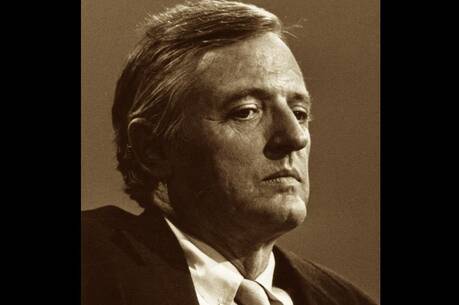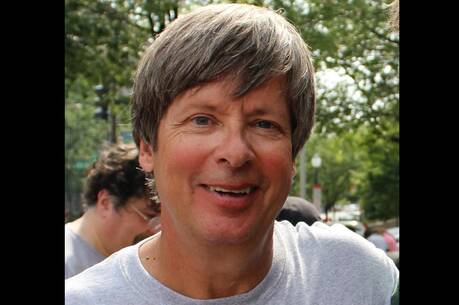Remembering Ray
Millions of readers are familiar with the oeuvre of Joyce Carol Oates, who has written well over 100 books of fiction, short stories, plays and poetry and is the recipient of numerous literary awards.
In A Widow’s Story Oates describes in wrenching detail her excruciating grief after the death of her husband, Raymond Smith, following a short illness three years ago. She is overcome by a “kind of visceral terror” and sinks into depression, loses weight, endures sleepless nights and blames herself for not taking better care of her husband.
“I just feel exhausted, groggy around people and want to crawl away somewhere and sleep,” she tells a friend.
She struggles with resentment, despair, rage, bitterness, fury and guilt and often thinks about suicide, but in the end rejects that option. Within days of her husband’s death, the author’s “consoling fantasy” is to “swallow as many pills as seem feasible, to put myself to sleep; that is, to sleep forever; for truly I want to die, I am so very tired.” Oates accumulates bottles of pills for depression and worries that she will become addicted.
Oates is assailed by a voice she identifies as a basilisk, a mythical lizard-like monster that insists she is “utterly unloved…of no more worth than a pail of garbage.” She is so paralyzed by grief that she has neither the physical nor mental energy to begin writing again. “No more could I plan a new novel than I could trek across the Sahara or Antarctica,” she says.
Momentary consolation comes when she discovers an unsent Valentine card “To My Beloved Wife” and a short phone message left the very night Smith died: “This is your honey calling.”
The author effectively uses repetition, returning again and again to the days before and immediately after the death of her 77-year-old husband, the highly regarded founder and editor of The Ontario Review, who awoke early one morning in February 2008 not feeling well. Oates insisted on taking him to the emergency room at nearby Princeton Medical Center in New Jersey, where he was diagnosed with pneumonia. They both expected a quick recovery but within a week Oates received a call, at 12:38 a.m., requesting that she come quickly. When she arrived at the hospital, her husband was dead. She cannot grasp that awful fact and wishes she could “stop time…reverse time.”
Library shelves are filled with books about grief. Some people may compare this one with Joan Didion’s affecting memoir, The Year of Magical Thinking, which became a widely praised best-seller six years ago. But comparing grief memoirs misses the point that there is no single way to grieve. For Oates, grief is “like a sodden overcoat the widow must wear.”
We do not learn how long the author suffered or how she is doing today because the book covers a period of only a few months after her husband’s death.
Oates struggles, without success, to find meaning in her numbing grief. “I am no longer convinced that there is any inherent value in grief,” she writes. “Or, if there is, if wisdom springs from the experience of terrible loss, it’s a wisdom one might do without.” She wonders if a widow’s grief is “sheer vanity; narcissism; the pretense that one’s loss is so special, so very special, that there has never been a loss quite like it.”
The book quotes extensively from e-mail messages to and from Oates, although in many cases she leaves out the sender’s name, believing it is “unconscionable” to humiliate others in the name of full disclosure. She rails against a deluge of sympathy baskets sent by well-meaning friends. She tosses many of them into the trash and pleads, “No! No more of this! Please have mercy.”
Oates becomes intensely curious about her husband’s early life, wondering if she ever really knew him. Her husband had grown up in a strict Catholic family at a time when many such families hoped that one of their sons would become a priest. Smith entered a Catholic seminary at age 18, but within months he quit, which led to estrangement from his father, who believed he would be held responsible if his son went to hell. Whenever Oates tried to bring up the subject of Smith’s seminary experience and loss of faith, he refused to talk about it.
Oates, too, was raised in a Catholic family, although no one in her family discussed religion. Surprisingly, the author says almost nothing about her own spiritual beliefs. If she ever wonders what happens after physical death, she gives no hint of it here. Yet she acknowledges being touched when her friend Gloria Vanderbilt gave her a small statue of St. Theresa.
On the last page of this intensely felt memoir, Oates briefly mentions a small dinner party for some Princeton colleagues, including a neuroscientist she was meeting for the first time. What she does not say is that she and the neuroscientist later married.
That tantalizing and unexpected turn of events may have served as a bridge that led Oates from crippling grief to a new, happier life, which I hope will become the subject of a sequel.
This article also appeared in print, under the headline “Remembering Ray,” in the April 25, 2011, issue.







